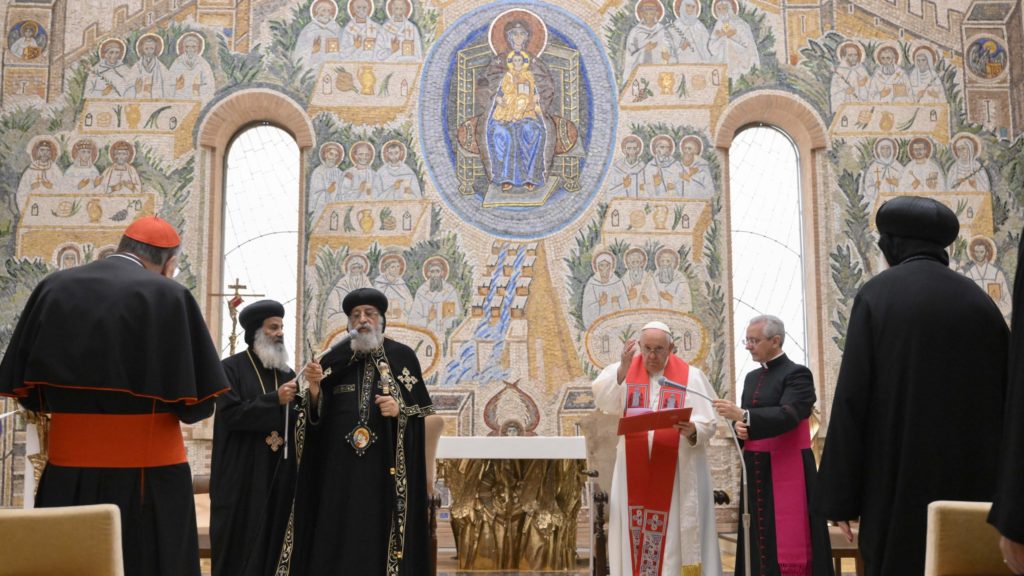ROME — When Pope Francis met his opposite number from Egypt’s Coptic Church on Thursday, Pope Tawadros II, he made a historic announcement: With Tawadros’ consent, 21 Coptic martyrs have been inserted into the Roman Martyrology, meaning the official compendium of saints recognized by the Catholic Church.
The gesture is not quite unprecedented. In 2001, under St. Pope John Paul II, certain Orthodox saints who lived after the historical separation between the Eastern and Western churches were incorporated into the martyrology.
It remains exceedingly rare, however, for the Catholic Church to extend official recognition to non-Catholic saints, and this is the first time the figures involved are all contemporary.
These Coptic martyrs were victims of the Islamic State. They were Egyptian construction workers who had been kidnapped in December 2014 and January 2015 by ISIS militants in Libya, and a video published by ISIS on Feb. 15, 2015, showed all 21 being beheaded.
The men can be heard crying out “O Lord Jesus!” and a caption to the video declared “they invoke their idol and they die in their paganism,” leading the Coptic Church to conclude they died for their Faith and to proclaim them martyrs.
Thursday’s action by Pope Francis to include these Coptic Orthodox martyrs in Catholicism’s official register represents the culmination of a trajectory that began under John Paul, which is to embrace the concept of an “ecumenism of blood” in the new martyrs of the 20th and 21st centuries, who are shared in common by all Christian confessions.
To begin with, a fact: Statistically speaking, the 20th and 21st centuries have produced a greater number of Christian martyrs than any previous era of Church history, and by some order of magnitude. According to one well-known estimate, some 70 million Christians have been martyred over the course of history, with half that total coming in the 20th century under fascist and communist regimes.
John Paul was especially sensitive to that reality, having grown up under the Nazis and came of age as a priest and bishop under the Soviets. He also knew full well that Catholics had no monopoly on martyrdom, and saw this common inheritance as a key force underlying the press for Christian unity.
As early as 1994, in his apostolic letter “Tertio Millennio Adveniente” (“As the Third Millennium Approaches”) looking forward to the Great Jubilee in 2000, John Paul reflected on the common legacy of martyrdom.
“At the end of the second millennium, the Church has once again become a Church of martyrs,” he wrote. “The witness to Christ borne even to the shedding of blood has become a common inheritance of Catholics, Orthodox, Anglicans and Protestants.”
In the letter, John Paul called for the witness of these contemporary martyrs not to be forgotten, and emphasized that the task of preserving their memory “cannot fail to have an ecumenical character and expression.”
One year later, in 1995, John Paul published “Ut Unum Sint” (“That They May be One”), his Magna Carta for the ecumenical movement. In it, his call for a shared commemoration of the martyrs became even more explicit.
“In a theocentric vision, we Christians already have a common martyrology,” the pope wrote.
“This also includes the martyrs of our own century, more numerous than one might think, and it shows how, at a profound level, God preserves communion among the baptized in the supreme demand of faith, manifested in the sacrifice of life itself,” John Paul said.
By 1998, the concept of a common martyrology for the jubilee year was gathering momentum. The Central Committee of the Great Jubilee wrote to national-level preparatory commissions and made the proposal explicit.
“It could be useful to compile a ‘common calendar’ or an ‘ecumenical martyrology,’ a compendium of Christians — Catholic, Orthodox, Anglican, Protestant — who have rendered testimony to Christ our Savior, sometimes even by shedding their blood,” the commission suggested.
The idea of a common martyrology ran into theological opposition, however, on the grounds that it presumably would include Protestant and Orthodox saints who held positions contrary to Catholic teaching, thereby inviting the faithful to emulate models of holiness who were also, at least formally speaking, heretics.
As a result, the idea didn’t come to full flower for the jubilee. Yet undeterred, John Paul staged an ecumenical service dedicated to the new martyrs on May 7, 2000, at the Roman Colosseum. Seventeen examples of ecumenical martyrs, including Martin Luther King Jr. in the United States, were mentioned during the service, which was conducted by the pope in tandem with clergy from 18 Orthodox and Protestant traditions.
This emphasis on the common legacy of the new martyrs has been picked up by Francis, beginning with a 2013 interview shortly after his election.
“Today there is an ecumenism of blood,” Francis said. “In some countries, they kill Christians for wearing a cross or having a Bible, and before they kill them they do not ask them whether they are Anglican, Lutheran, Catholic, or Orthodox.”
“To those who kill we are Christians,” he said. “We are united in blood, even though we have not yet managed to take necessary steps toward unity between us and perhaps the time has not yet come. Unity is a gift that we need to ask for.”
In a 2018 address to the World Council of Churches, he repeated the point.
“May we never forget that our ecumenical journey is preceded and accompanied by an ecumenism already realized, the ecumenism of blood, which urges us to go forward,” he said.
What all this suggests is that while the concept of a common martyrology may be a way off, popes are increasingly inclined to provide a workaround by making the Catholic compendium of saints itself ecumenical.
Francis’ historic gesture Thursday thus seems like anything but a one-off gesture, and more like the beginning of what could become a habit.

